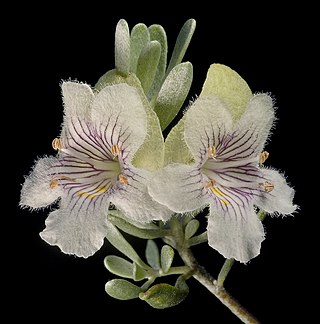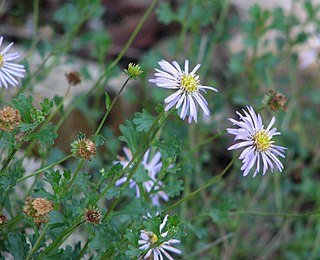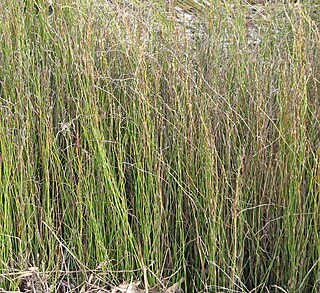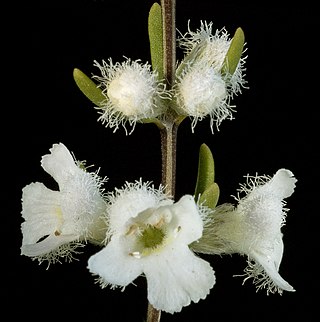
Scaevola is a genus of flowering plants in the Goodenia family, Goodeniaceae. It consists of more than 130 species, with the center of diversity being Australia and Polynesia. There are around 80 species in Australia, occurring throughout the continent, in a variety of habitats. Diversity is highest in the South West, where around 40 species are endemic.

Leucopogon is a genus of about 150-160 species of shrubs or small trees in the family Ericaceae, in the section of that family formerly treated as the separate family Epacridaceae. They are native to Australia, New Zealand, New Caledonia, the western Pacific Islands and Malaysia, with the greatest species diversity in the south-west of Western Australia. Plants in this genus have leaves with a few more or less parallel veins, and tube-shaped flowers usually with a white beard inside.

Prostanthera, commonly known as mintbush or mint bush, is a genus of about 100 species of flowering plants in the mint family Lamiaceae, and all are endemic to Australia. Plants are usually shrubs, rarely trees with leaves in opposite pairs. The flowers are arranged in panicles in the leaf axils or on the ends of branchlets. The sepals are joined at the base with two lobes. The petals are usually blue to purple or white, joined in a tube with two "lips", the lower lip with three lobes and the upper lip with two lobes or notched.

The Gnaphalieae are a tribe of flowering plants in the family Asteraceae. It is most closely related to the tribes Anthemideae, Astereae, and Calenduleae.

Isotoma is a genus of annual and perennial herbs in the family Campanulaceae and are native to Australia and New Zealand.

Lechenaultia is a genus of flowering plants in the family Goodeniaceae, the species native to Australia with one species also occurring in New Guinea. Plants in the genus Lechenaultia are glabrous shrubs or herbs with needle-shaped leaves, more or less sessile flowers with five sepals and five blue, white, or yellow and red petals in two unequal lobes, the fruit an elongated capsule.

Dampiera is a genus of about 70 species of flowering plants in the family Goodeniaceae, all of which are endemic to Australia. Plants in the genus Dampiera are subshrubs or herbs with sessile leaves, flowers with five small sepals and blue, violet or pink, rarely white, two-lipped flowers.

Bossiaea is a genus of about 78 species of flowering plants in the pea family Fabaceae and is endemic to Australia. Plants in this genus often have stems and branches modified as cladodes, simple, often much reduced leaves, flowers with the upper two sepal lobes larger than the lower three, usually orange to yellow petals with reddish markings, and the fruit a more or less flattened pod.

Lepidosperma is a genus of flowering plant of the family Cyperaceae. Most of the species are endemic to Australia, with others native to southern China, southeast Asia, New Guinea, New Caledonia and New Zealand.

Conostylis is a genus of perennial herbs in the Haemodoraceae family, commonly known as cone flowers. All species are endemic to the south west of Western Australia.

Calotis is a genus of herbs or small shrubs in the daisy family Asteraceae. Most of the species are native to Australia, while two occur in Asia.

Hemigenia is a genus of flowering plants in the mint family, Lamiaceae and is endemic to Australia where most species occur in Western Australia, although some are also found in New South Wales and Queensland. Plants in this genus are shrubs or bushes with simple leaves and tube-shaped flowers with the petals forming two "lips" - the upper one with two lobes and the lower one with three.

Velleia is a genus of herbs in the family Goodeniaceae. Of the 22 species, 21 are endemic to Australia, and one is endemic to New Guinea. The genus was named by James Edward Smith, after Thomas Velley.

Styphelia is a genus of shrubs in the family Ericaceae, native from Indo-China through the Pacific to Australia. Most have minute or small leaves with a sharp tip, single, tube-shaped flowers arranged in leaf axils and with the ends of the petals rolled back with hairs in the inside of the tube.

Lepyrodia is a plant genus in the family Restionaceae, described as a genus in 1810.

Andersonia is a genus of mostly small, evergreen shrubs in the family Ericaceae and is endemic to the Southwest Botanical Province in Western Australia.

Schoenus is a predominately austral genus of sedges, commonly known as bogrushes, or veldrushes in South Africa. Species of this genus occur mainly in South Africa, Australia and Southeast Asia. Others are found in scattered locations worldwide, from Europe to Asia, North Africa and the Americas. Three species occur in the peatlands of southern South America, including S. antarcticus which is found in Tierra del Fuego, where it forms a component of hyperhumid Magellanic moorland.

Microcorys is a genus of flowering plants in the family Lamiaceae, first described in 1810. The entire genus is endemic to Australia.
- Microcorys barbataR.Br. - Western Australia
- Microcorys boxwoodNewbey - Western Australia
- Microcorys capitata(Bartl.) Benth. - Western Australia
- Microcorys cephalanthaB.J.Conn - Western Australia
- Microcorys ellipticaB.J.Conn - Northern Territory
- Microcorys eremophiloidesKenneally - Western Australia
- Microcorys ericifoliaBenth. - Western Australia
- Microcorys exsertaBenth. - Western Australia
- Microcorys glabra(Bartl.) Benth. - Western Australia
- Microcorys lenticularisF.Muell. - Western Australia
- Microcorys loganiaceaF.Muell. - Western Australia
- Microcorys longifloraF.Muell. - Western Australia
- Microcorys longifolia(Benth.) Benth. - Western Australia
- Microcorys macredieanaF.Muell. - Northern Territory
- Microcorys obovataBenth. - Western Australia
- Microcorys pimeloidesF.Muell. - Western Australia
- Microcorys purpureaR.Br. - Western Australia
- Microcorys queenslandicaC.T.White - Queensland
- Microcorys subcanescensBenth. - Western Australia
- Microcorys tenuifoliaBenth. - Western Australia
- Microcorys virgataR.Br. - Western Australia
- Microcorys wilsonianaB.J.Conn - Western Australia

Haemodorum is a genus of herbs in the family Haemodoraceae, first described as a genus in 1798 by James Edward Smiith. The genus is native to New Guinea and Australia. The type species is Haemodorum corymbosum Vahl, first described by Martin Vahl in 1805.

Chlorophytum laxum is a flowering plant species in the genus Chlorophytum, widespread through tropical Africa, Asia, and Australia.




















